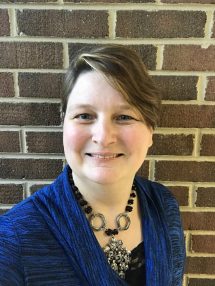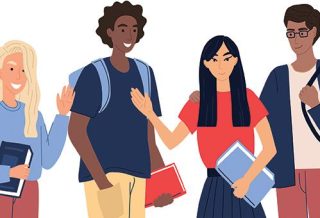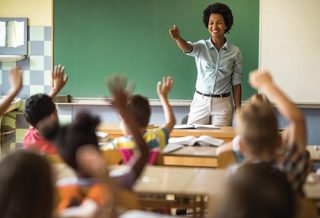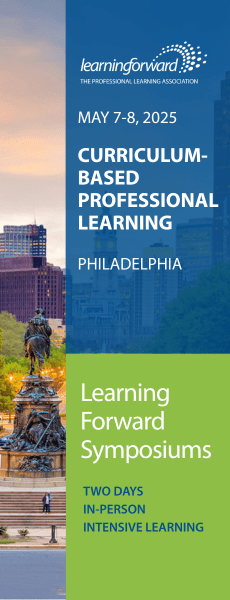FOCUS
ONLINE EXCLUSIVE: Virginia district builds educator SEL through professional learning
By Allison Sansone, Anna H. Surratt and Chelyse Stefanik-Miller
Categories: Personalization, Social & emotional learningAugust 2021
What does it look like when students and adults develop and practice their social and emotional skills in a safe and equitable environment? What does it feel like to prioritize the well-being of individuals and the collective community? What might be required to accomplish such a vision?
Virginia Beach City Public Schools is working to answer these questions, using professional learning to strengthen the capacity and competency of adults to model social and emotional learning (SEL) skills and mindsets, create structures that foster collaboration and trust, and integrate SEL directly into classroom practice.
Guided by the Collaborative for Academic, Social, and Emotional Learning’s (CASEL) District Framework and Guide to Schoolwide SEL (CASEL, 2018), we leverage professional learning to build the capacity of teachers, school leaders, and other critical staff to:
- Build supportive classroom environments;
- Integrate SEL into instruction; and
- Deliver explicit SEL instruction.
Underpinning this work is the belief that our staff’s social and emotional competence and well-being are directly linked to our students’ social, emotional, and academic success.
A critical part of building educators’ capacity is helping them intentionally consider the different needs of all learners. Every learner (adult and student) needs varying levels of support and time to progress from awareness, to understanding, to ultimately internalizing and integrating SEL into teaching and learning.
''A critical part of building educators’ capacity is helping them intentionally consider the different needs of all learners.'' #TheLearningPro Share on XIn a diverse school district comprising over 80 schools, 14,000 employees, and 64,000 students, the call to provide just the right support and time for staff is a tall order. But our district is committed to providing personalized opportunities for all staff to build awareness, practice new skills, and become passionate advocates for SEL.
Supportive classroom environment
Students will remember for years to come the way school made them feel, and it will affect the way they learn as well as whether they pursue future education. Positive feelings about education and the safety to learn start with a supportive environment.
A supportive classroom environment is nurturing, culturally responsive, focused on building relationships and community, and serves as the springboard for academic and social and emotional learning (CASEL, 2018).
''A supportive classroom environment is nurturing, culturally responsive, focused on building relationships & community, & serves as the springboard for academic & SEL.'' #TheLearningPro Share on XThis vision of a supportive learning environment prompted the district’s educators to search for an evidence-based model that would help create the conditions and environment through which students do their best learning. The Responsive Classroom approach emerged as a favorite option for schools across the district to engage in supportive practices such as morning meetings, closing circles, and student advisories that foster a sense of belonging and emotional safety for everyone.
We have committed to building the capacity of all staff to implement responsive practices and cultivate a responsive environment because we believe that developing a supportive climate and culture is the collective responsibility of all staff: administrators, teachers, and support staff.
Each staff group is critical to the implementation and creation of supportive classroom environments, so we facilitate various professional learning pathways for each group to model SEL skills and mindsets, design and implement structures that foster collaboration and trust, and integrate SEL directly into classroom practice (Responsive Classroom, 2021). The opportunities for each of these staff groups create consistency in understanding and applying evidence-based practices that create supportive learning environments and aim to meet the needs of the whole child.
School-based administrators and district leadership have opportunities to develop their capacity in various ways, from bringing leadership teams together for a guided inquiry on a problem of practice to sessions on how to cultivate responsive practices aligned to the SEL competencies in classrooms. Administrators have the freedom to exercise choice and autonomy in selecting among these personalized professional learning offerings relevant to their needs.
Similarly, teachers have personalized professional learning opportunities from which to choose to increase their capacity to implement supportive classroom practices. For example, teachers that join our invitational Responsive Classroom Academy self-select a community of practice and engage in cycles of inquiry and reflection.
These learning communities meet throughout the year, working together to continually improve the implementation of morning meetings, closing circles, interactive learning structures, responsive language, and developmentally appropriate practices to serve as models within the district (Responsive Classroom, 2021).
Individual teachers also engage in learning at workshops that take place throughout the year centered on different responsive practices. In some cases, administrators have specifically asked for support personalizing these district-level learning experiences for use at their school because the sessions model intentional instructional design that creates the conditions for teachers to engage in practice and reflection.
School support staff — who are critical to the work of creating safe and caring classroom environments — engage in a learning series differentiated specifically for their role. This series builds awareness and understanding of and capacity to create safety and belonging, use developmentally appropriate practices and responsive language, and practice interactive modeling. These practices create an inclusive learning environment that develops and strengthens the social and emotional skills students need to become balanced, resilient learners.
Across these groups, educators are eager to share the impact Responsive Classroom has made on their supportive classroom environments. As the pandemic began and the pivot to virtual learning occurred, teachers continued to use morning meetings as a way to maintain normalcy, support learning, build community, and create safety.
The value of responsive practices had been well-established before the pandemic, so administrators and teachers advocated continuing these practices into virtual learning. Thus was born the morning meeting motivator, a curation of resources, ready-to-use morning meetings, and teacher spotlights where teachers share the impact of morning meetings on their students’ social and emotional growth and well-being, especially through the changes experienced during the pandemic, and implementation tips.
While the format and structure have evolved through the year in response to educator need, the purpose of supporting teachers to establish authentic, trusting relationships with and among students has remained constant.
Integrating SEL into instruction
Integrating SEL into instruction requires educators to move from knowing about SEL to embedding it into the teaching practice of instructional content. One way is through using the three SEL signature strategies: inclusive openings, engaging strategies, and intentional closings. These structures collectively work together to foster academic mindsets and provide a framework to align SEL with academic objectives.
Want to embed #SEL into your teaching practice? Use the three SEL signature strategies: inclusive openings, engaging strategies, & intentional closings. #TheLearningPro Share on XInclusive openings set the tone for learning and support the contribution of all voices. For example, one strategy asks learners to reflect on a statement, image, or prompt and move to a corner that matches their choice. There, they share their rationale for choosing that corner with others before the whole group reconvenes.
This helps students practice the responsible decision-making skills of analyzing and evaluating situations as they choose and discuss their choice, and it supports the social awareness skills of perspective-taking and empathy as they listen to understand each other’s choices and reasoning.
Engaging strategies are inherently infused with SEL and offer a balance of interactive and reflective opportunities to make sense of content in responsive ways to students’ physical, cognitive, and social needs. For example, one multidisciplinary engaging strategy empowers students to practice social and self-awareness as they explore others’ perspectives and articulate their own thoughts and assumptions.
With this strategy, students look at an event or system and take on the perspective of different people, exploring these questions:
- Think: How does this person understand this event/system and his or her role within it?
- Feel: What is this person’s emotional response to the event/system and to his or her position within it?
- Care: What are this person’s values, priorities, or motivations with regard to the event/system? What is important to this person?
Intentional closings create space for reflection and forward thinking. For example, students consider this question: “Thinking about what you heard and learned today, what is one takeaway you want to try, and why?” A takeaway can be an idea, a strategy, a tool, or an action step.
We provide explicit teaching and ready-made resources for implementing the three types of signature strategies. The district has developed a stockpile of strategies aligned to our graduate profile, ensuring students are future-ready, and the five core SEL competencies: self-awareness, self-management, relationship skills, social awareness, and decision-making. Each resource includes directions, modifications for virtual learning environments, anecdotal scenarios, and ready-made editable templates.
In addition, both synchronous and asynchronous professional learning explicitly model and integrate the three SEL signature strategies. For example, one asynchronous professional learning course opens with a strategy in which participants use images to create metaphors to make meaning of the content regardless of prior knowledge or experience with the topic.
Inclusive openings like this provide opportunities to strengthen perspective-taking and respect for others, which are part of the self and social awareness components of SEL, along with the relationship skills of listening as everyone works to support equity of voice.
Engaging strategies provide structure to make meaning of the content and create opportunities for individual and collective reflection. One strategy asks participants to share three strategies to support students, two direct quotes that align with teaching and learning beliefs, and one characteristic of effective feedback that connects to current instructional practices.
This embedded opportunity to practice SEL skills supports adult learners to exercise self-awareness by assessing their strengths and limitations as well as social awareness as they practice clear communication with colleagues and facilitators.
All courses conclude with intentional closures, such as one in which in which participants exercise self-efficacy to consider and prioritize how they will apply their new learning in their practice.
Adult learners appreciate the consistent, explicit modeling and integration of SEL strategies into professional learning. “Almost all successful professional learning I’ve attended in recent years has modeled the signature strategies,” one teacher said. “Pulling on these ideas allows me to incorporate SEL into strong classroom instruction, which I want to do every day. SEL skills can fit naturally into the sequence of a lesson.”
Another noted that the strategies “give me a starting point to replicate with my staff. The strategies allow me to check in with myself, practice, and build confidence to facilitate the strategies.”
Explicit instruction
Explicit instruction is a necessary element of effective social and emotional learning in the classroom. Explicit SEL instruction refers to consistent, intentional opportunities for students to cultivate, practice, and reflect on social and emotional competencies in ways that are developmentally appropriate and culturally responsive (CASEL, 2018).
''Explicit instruction is a necessary element of effective social and emotional learning in the classroom.'' #TheLearningPro Share on XExplicit SEL is purposeful for our students. It dives directly into a sea of topics such as developing a growth mindset, identifying and using stress management strategies, and fostering empathy. Instruction is responsive to student needs and supported through embedded opportunities for reflection and discussion.
In our district, we believe adults also need explicit opportunities to cultivate, practice, and reflect on SEL competencies. Educators have multiple opportunities to cultivate their own SEL skills through professional learning that supports explicit SEL instruction.
These opportunities include a dynamic, online professional learning experience that addresses all three of the components of SEL we describe in this article. A webinar on explicit SEL instruction includes a panel of teachers from the district who demonstrate evidence of internalized and integrated social and emotional learning in their daily teaching.
This passionate group shares resources and ideas focused on their classroom practices, including SEL choice boards, mindfulness exercises, self-care strategies, celebrations, intentional teacher language, using Flipgrid to connect and build relationships, and emotion check-ins using the Zones of Regulation (Kuypers, 2021).
Learners see tangible examples of how the teacher panel explicitly teaches SEL and the compelling rationale for panel members’ intentional instructional decisions. Participants explore questions and wonderings in a facilitated question-and-answer session.
Powerful lever for SEL
As we continue to address the questions of what it looks, sounds, and feels like to build SEL for all educators and students, we emphasize professional learning as the key to building that capacity. If we are to effectively and deeply engage students in social, emotional, and academic learning, then all staff must have safe, equitable, and prioritized opportunities to experience the same. Professional learning that provides staff with personalized opportunities to internalize and apply their learning is the most powerful lever for high-quality SEL for students.
For more information
Virginia Beach City Public Schools created an SEL Stockpile, which includes strategies and resources to help educators create safe, equity-centered, productive learning and working spaces for all students and adults. The SEL Stockpile is available at sites.google.com/vbschools.com/selstockpile/home.
References
Collaborative for Academic, Social, and Emotional Learning (CASEL). (2018). SEL 3 signature practices playbook (No. 3). schoolguide.casel.org/uploads/2018/12/CASEL_SEL-3-Signature-Practices-Playbook-V3.pdf
Kuypers Consulting. (2021). The Zones of Regulation: A concept to foster self-regulation & emotional control. zonesofregulation.com/index.html
Responsive Classroom. (2021). Center for Responsive Schools. www.responsiveclassroom.org/about/crs/
Categories: Personalization, Social & emotional learning
Recent Issues
BUILDING BRIDGES
December 2024
Students benefit when educators bridge the continuum of professional...
CURRICULUM-BASED PROFESSIONAL LEARNING
October 2024
High-quality curriculum requires skilled educators to put it into...
LEARNING TO PIVOT
August 2024
Sometimes new information and situations call for major change. This issue...
GLOBAL PERSPECTIVES
June 2024
What does professional learning look like around the world? This issue...













